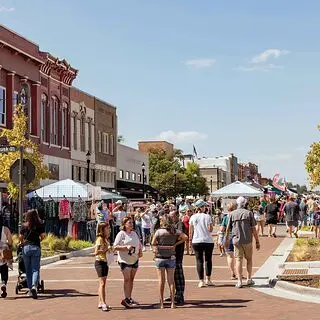
Street Smart: A Focus on Downtown Helps Denison, Texas, Sustain its Momentum
Born of the railroad, not far from where the Red River draws its winding boundary between Texas and Oklahoma, the small city of Denison has long been defined by its ability to adapt and endure.
Once a bustling junction for three major rail lines, Denison grew rapidly in the late 19th century, tying its identity to the tracks. But when Union Pacific Railroad absorbed the Katy Railroad decades later, this North Texas city was forced to reckon with the sudden loss of hundreds of jobs and find a way back from the economic void left behind.
It found a path forward through its historic downtown, a seven-block stretch of turn-of-the-century architecture, in hopes of preserving its charm while building a foundation for future growth. When a devastating fire tore through four buildings in the 300 block in December 1989—early in its preservation efforts—local leaders responded by transforming the scarred space into a public park that would go on to serve as a community gathering spot. When another fire roared through a different section in 2019, Denison pressed forward. This spring, the city cut the ribbon on a new visitors center built on the site of the second fire.
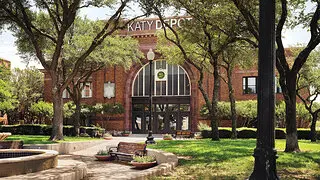
photo by: Craig Washburn
The Katy Depot is an adaptively reused former passenger station in Denison, Texas.
“It’s a place where life happens, and resilience is a throughline,” says Wendy Acosta, a local artist and designer whose original coworking space on Denison’s Main Street, The Desk & Easel, was among the 2019 fire’s casualties. Her “Main Street adventure,” as she calls it, began just a few years before with the purchase of a historic building that she renovated into loft apartments and a shared workspace. In the aftermath of the fire, surrounded by the support of fellow business owners and city officials, The Desk & Easel recommitted to downtown. Acosta eventually purchased and rehabilitated an early 1900s house just off Main Street, where her business now continues to grow.
“There’s much more effort and value in the preservation of the buildings and the uniqueness that results from that.”
Ben Munson
These days, Denison (population 26,684) faces a new kind of transformation as it strives to hold onto its small-town spirit while staying relevant as a destination amid the region’s growth. A massive redevelopment of its downtown streetscape is underway, including the return of the red brick that once paved the heart of the city. Above the storefronts of antiques malls, clothing boutiques, and coffee spots, lofts are attracting new residents. As downtown preservation efforts pay off, locals and leaders alike are engaged in a broader conversation about growth, opportunity, and how to shape Denison’s next chapter without losing sight of its past.
“It makes you want to be here as a business owner,” Acosta says while sitting at a paint-splattered table in her studio just behind The Desk & Easel’s three floors of shared space. “That carries out onto the street so when you as the day-tripper, the shopper, or somebody just passing through town, when you’re walking around going from shop to shop, that’s the feeling you get. And that’s why people keep coming back, and [why] people are wanting to move into the area.”
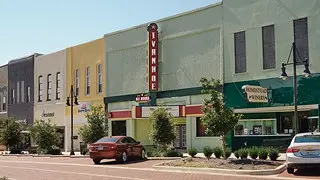
photo by: Craig Washburn
Ivanhoe Ale Works and other craft breweries attract beer enthusiasts.
Founded in 1872, Denison was laid out in anticipation of the arrival of the Missouri-Kansas-Texas (M-K-T) Railroad, also known as the Katy Railroad. It’s said that within six months of the railroad’s opening, 3,000 people called the town their home. The train offered Denison an early distinction: The city became the place where the United States’ first north-south railway west of the Mississippi was linked. Denison’s population continued to grow over the following decades as it developed into a railroad hub.
But in 1989, local leaders recognized that Denison was at a crossroads. Union Pacific’s merger with the M-K-T that year resulted in the loss of 600 jobs in the community, half of them in downtown Denison, as the rail operations and headquarters were moved out of town. Already the city was dealing with the fallout from a highway bypass that pulled drivers away from Main Street and out toward big-box stores. That included travelers passing through on their way up to the Choctaw Casino & Resort in Durant, Oklahoma, across the state border, and those who would have been drawn to Denison’s proximity to Lake Texoma, a sprawling reservoir known for its striped bass, catfish, and network of scenic campsites.
Without a deliberate reinvestment effort, Denison risked going the way of so many other Texas towns, walled off by nearby freeways and filled with empty storefronts.
“Denison has only a limited amount of industry and only a limited amount of sales tax revenue,” says Ben Munson, a local business and real estate attorney who served as Denison’s mayor early in its downtown revitalization efforts. “So in making it a destination, the concept was to provide a structure for businesses to be able to be successful and then that would in turn generate sales tax for the city.”
Preserving the character of Denison’s downtown while encouraging new activity there became a cornerstone of efforts to build local buy-in and boost tourism. Recognizing the need for better access to retail, the city overhauled Main Street to prioritize improved parking and reverse a 1960s redesign that had introduced curved, serpentine lanes. Financial incentives helped building owners pull down the dated metal slipcovers that had long concealed the historic architecture of the corridor’s oldest buildings. The city passed a historic preservation ordinance to protect downtown and set up a financing model, based on property valuations, to cover the costs of reinvestment.
Over the years, once-vacant properties started filling up with new tenants, in many cases aided by economic development grants, while empty storefronts were dressed with signs advertising local events.
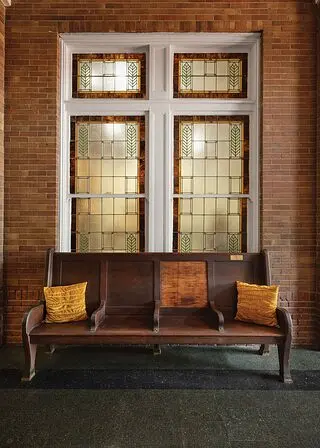
photo by: Craig Washburn
The Katy Depot retains original details such its exterior brickwork, stained-glass windows, and passenger benches.
Community events popped up downtown, including the Doc Holliday: Saints and Sinners Festival, named after the famous gunslinger who once had a dentistry office there. The growing culture downtown even helped spur the community to fundraise to keep the location of the high school football stadium, along with its accompanying foot traffic, just off Main Street.
“[After] the railroad originally came into Denison, Denison was, relatively speaking throughout the state, a more prominent city and had a lot of historically significant buildings, and we’ve tried to maintain the ones that are still left,” says Munson, who comes by his commitment to history honestly. His office is in a brick building built in 1888 just off Main Street, and it bears his family’s name. “There’s much more effort and value in the preservation of the buildings and the uniqueness that results from that.”
“It’s a place where life happens, and resilience is a throughline.”
Wendy Acosta
Today, Main Street is a picturesque multiblock display of old and new. The historic Esler Paint & Paper Co. brick building contains a women’s consignment clothing store. Next door, Café Blackbird is carrying on a longstanding culinary tradition in a roughly 140-year-old stone-walled structure that has served as various eateries. The building sat vacant for more than a decade before reopening in 2020.
Down the street, Niche Coffee & Shop—housed in a bright, open space with rows of milk-glass lamps hanging overhead—replaced an old antiques mall but maintains the spirit of the building’s past, incorporating vendor stands with vintage and new goods. Along the same stretch are also wineries, art galleries, restaurants, a barber, bookstores, med spas, and a 24-hour gym.
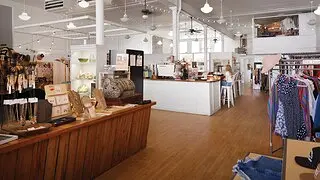
photo by: Craig Washburn
At Niche Coffee & Shop, customers can buy plants as well as new and vintage items.
At the eastern edge of downtown, a once-bustling traveler’s hotel now sits vacant, overlooking the rail lines and a decommissioned train. But the train’s bright green engine, still bearing the “MKT” initials of the railroad, serves as a striking backdrop for the Katy Depot, a passenger station built in 1911 that has since been rehabilitated and transformed into shops, restaurants, an event venue, and loft residences.
Denison’s bet on downtown seems to be yielding real returns: Once a quiet stretch of aging storefronts, the district is now responsible for 28% of the city’s sales tax revenue. Property values have followed suit. The investment has also translated to about 2.6 million annual visitors in recent years, including day-trippers from surrounding areas (Dallas is just over an hour’s drive away), bachelorette parties, visitors seeking out regional festivals, and history buffs. Near downtown is the Eisenhower Birthplace State Historic Site, a 10-acre plot of stately trees surrounding the white wood-frame house where President Dwight D. Eisenhower was born in 1890. It attracts 15,000 people a year.
And Denison has seemingly managed to retain some of the travelers it feared losing because of the highway bypass. At Pen & Page Weathered Books, Curated Art—a bookstore and art studio housed in an old bottling building—artist and owner Skip Weir says his customers often include Lake Texoma campers stopping in for their next title.
“We’ve been able to maintain our relevancy, and, much more than that, we’re thriving,” says Donna Dow, who has overseen downtown for 15 years as director of Denison Main Street.
I caught up with Dow during sound check for Music on Main, a free summer concert series that’s been bringing out about 1,500 people a week—with camping chairs in tow—to a park a couple of blocks behind Main Street. City officials want to bring the event back to Main once the redo of the streetscape is complete.
Locals hope the streetscape project, which is more than halfway done, will mark a significant chapter in Denison’s revitalization efforts. When finished next summer, Main Street will feature widened and more accessible sidewalks, updated landscaping, and red-brick pavers that hark back to the original surface laid more than a century ago. The city is also taking on critical upgrades below the surface, replacing aging water lines and drainage systems.
The construction has crept up Main Street, shutting down sections of the road and limiting parking. In response, Denison launched a “streetscape survival guide” to help businesses adapt, including grants to create safe rear entrances accessible through paths with names like Depot Alley. The city also secured adjacent parking lots to keep foot traffic downtown. It turned the alleyways and lots into artful extensions of downtown, with vibrant murals celebrating hometown heroes like Eisenhower, Tuskegee Airman Maj. Jewel Butler Sr., and Chesley “Sully” Sullenberger.
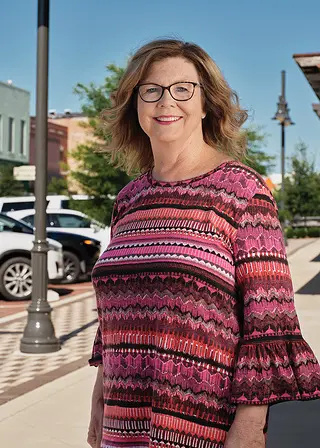
photo by: Craig Washburn
Donna Dow, director of Denison Main Street.
That intentionality was recently recognized by Main Street America, which named Denison Main Street one of three recipients of its Great American Main Street Award for 2025. The annual award honors communities that demonstrate excellence in comprehensive, preservation-based revitalization of their commercial districts. Denison stood out for its expansive community engagement and proactive support for local businesses throughout renovations and construction.
It would be disingenuous to pretend the ongoing construction, currently spanning roughly two blocks, doesn’t detract from the experience of strolling through downtown. Chain-link fencing surrounds the whirring machinery but does little to contain the construction dust. When I visited, it also obstructed the view of the historic Rialto Theater’s marquee, which proudly congratulated the city on its Main Street award.
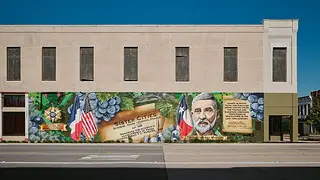
photo by: Craig Washburn
Renowned horticulturalist T.V. Munson is the subject of a downtown mural in Denison.
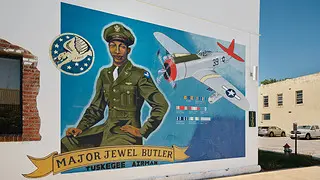
photo by: Craig Washburn
Tuskegee Airman Maj. Jewel Butler Sr. is depicted in a mural.
Dow recognizes it’s not an ideal setup for business owners, but she’s hoping people can look past the disruption toward the transformation to come. “I think they know that we just got to get through it and get to the other side and then it’s going to be absolutely wonderful,” Dow says.
“We’ve been able to maintain our relevancy, and, much more than that, we’re thriving.”
Donna Dow
Jenna Zapata first stumbled upon Denison several years ago when her family made the day trip from nearby Frisco for a Día de los Muertos celebration.
Soon after, she found herself browsing real estate listings and came across a vacant downtown building, a former feed store that had also once been a restaurant. She bought it for a deal in 2017. A lifelong artist—she sold her first piece in middle school—Zapata opened Zig Zag Galleries three years later.
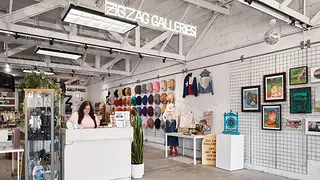
photo by: Craig Washburn
Artist and small business owner Jenna Zapata stands behind the counter inside Zig Zag Galleries, a creative hub.
Zig Zag is more of a creative hub than a standalone gallery. While art is featured toward the front of the space, the back area also includes curated thrifted clothing, a charm bar for personalized jewelry, hat-customizing stations, and regular creative workshops that draw in locals and visitors alike. Zapata has also cultivated a large online following, boosted by an e-commerce grant from the city, that tunes in as she live streams the process of making custom hats.
As the downtown redevelopment has marched forward, Zapata says she’s already seeing the foot traffic to match. The 27-year-old, among several young entrepreneurs finding success in Denison, views the growth on the horizon as a positive, and she describes it as an opportunity the close-knit community has worked to foster.
“It’s not a competition, and that’s one of the main things this town pushes—community-over-competition,” Zapata says. Businesses send visitors each other’s way, and welcome new arrivals to downtown. And the city’s open communication and willingness to listen to business owners, she adds, help make the momentum feel shared in Denison.
“It’s the people here that really make it,” Zapata adds. “Everyone is trying to help everybody out through all the renovation and all the growth.”
Donate Today to Help Save the Places Where Our History Happened.
Donate to the National Trust for Historic Preservation today and you'll help preserve places that tell our stories, reflect our culture, and shape our shared American experience.


